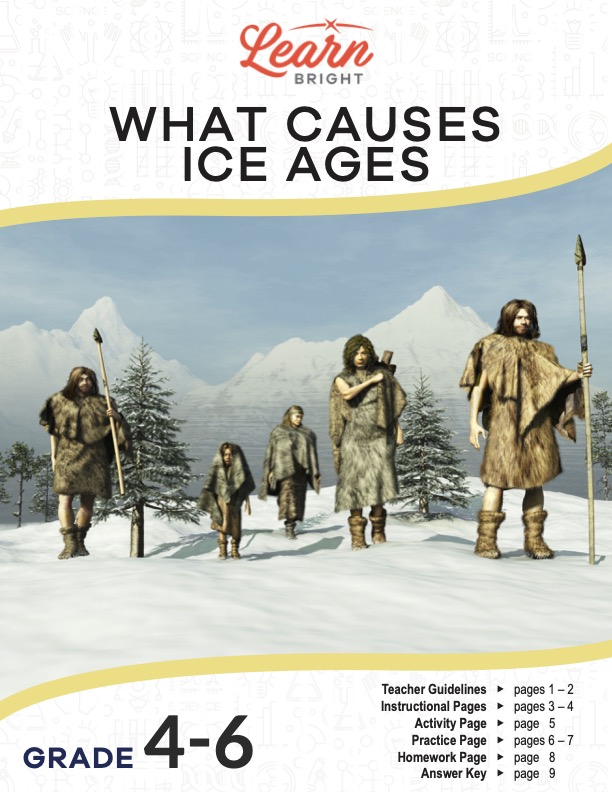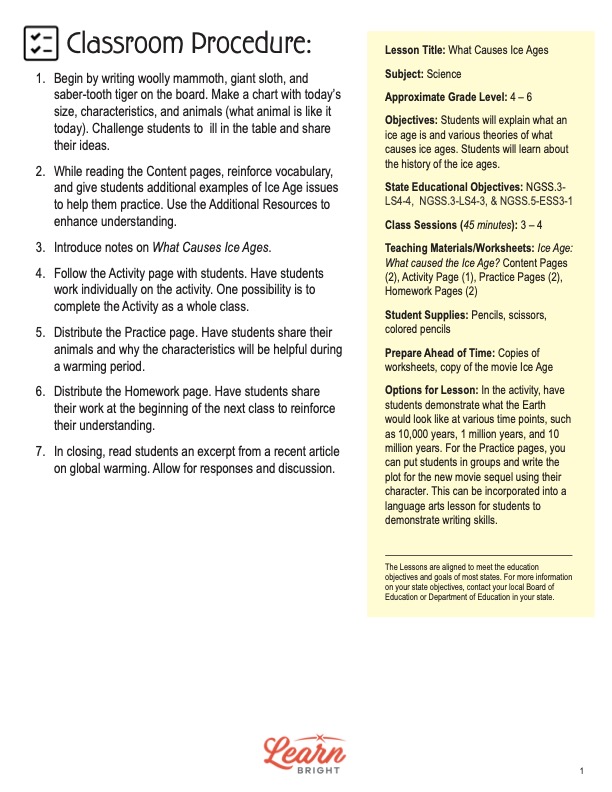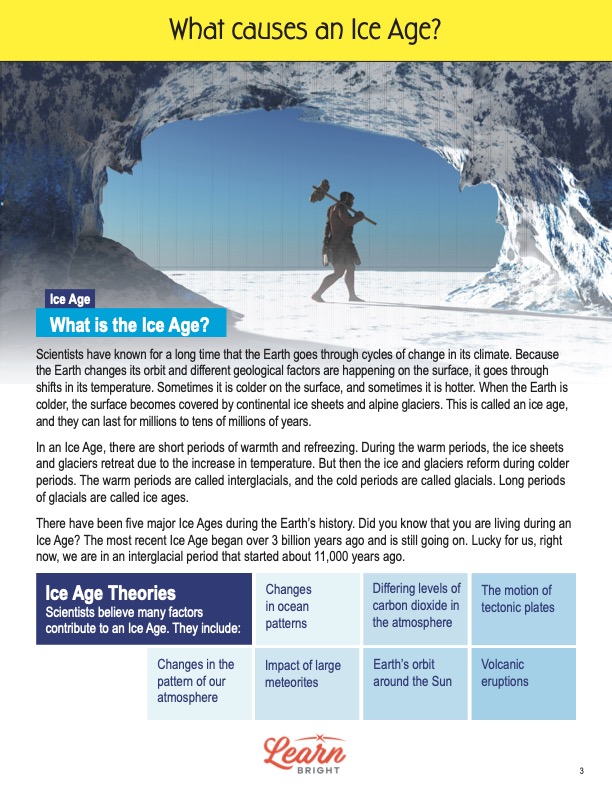Description
What our What Causes Ice Ages lesson plan includes
Lesson Objectives and Overview: What Causes Ice Ages focuses on the theories scientists have about the what can cause an ice age to occur. Students will discover information about these theories and learn about the various theories that have been proposed throughout history. They will also be able to create their own characters that could exist in an Ice Age movie. This lesson is for students in 4th grade, 5th grade, and 6th grade.
Classroom Procedure
Every lesson plan provides you with a classroom procedure page that outlines a step-by-step guide to follow. You do not have to follow the guide exactly. The guide helps you organize the lesson and details when to hand out worksheets. It also lists information in the yellow box that you might find useful. You will find the lesson objectives, state standards, and number of class sessions the lesson should take to complete in this area. In addition, it describes the supplies you will need as well as what and how you need to prepare beforehand. This lesson requires pencils, scissors, and colored pencils.
Options for Lesson
There are a number of suggestions in the “Options for Lesson” section of the classroom procedure page that you could incorporate into the lesson. Regarding the activity, you could have students demonstrate what the Earth would look like at various points in time. For instance, they could show what it looked like 10,000 years ago or a million years ago. An optional adjustment to the practice worksheet is to put students in groups and have them write the plot of a new movie sequel using the character they create. If you want, you could incorporate this activity into a language arts lesson for students to demonstrate their writing skills.
Teacher Notes
The teacher notes page provides an extra paragraph of information to help guide the lesson. It mentions that this lesson is meant to supplement the Ice Ages lesson plan. You can use the blank lines to write down any other ideas or thoughts you have about the topic as you prepare.
WHAT CAUSES ICE AGES LESSON PLAN CONTENT PAGES
What Is an Ice Age?
The What Causes Ice Ages lesson plan contains two content pages. Students first learn a little about the history of Earth in general. Scientists know that the Earth goes through cycles of change in its climate. Because the Earth changes its orbit, and because various geological factors occur on its surface, the planet’s global temperature shifts regularly.
Sometimes the surface is colder, and other times it’s hotter. During the times when the Earth is colder, continental ice sheets and alpine glaciers start to cover the surface. These periods are what scientists call an ice age. And an ice age can last for millions or even tens of millions of years.
Even during these really cold periods, there are shorter periods of warmth and refreezing. Ice sheets and glaciers retreat due to the increase in temperature. Then the ice and glaciers reform when it starts to get colder again. We call these warm periods interglacials, and the cold periods glacials. We consider long periods of glacials ice ages.
Throughout Earth’s history, there have been five major ice ages. It may surprise students to learn that the Earth is actually experiencing an ice age right now! The most recent ice age began around 3 million years ago and is still going on today. Luckily, we are in an interglacial period that started about 11,000 years ago, so it’s not too cold!
Theories
The lesson describes several ideas that scientists have about the factors that contribute to an ice age. These include changes in ocean patterns, changes in the pattern of our atmosphere, the motion of tectonic plates, and volcanic eruptions. Other things that might play a role in causing an ice age are different levels of carbon dioxide in the air, the Earth’s orbit, and the impact of large meteorites.
Scientists know all these factors can affect the Earth’s climate. However, nobody is completely sure how much of an effect any of these factors actually has. That being said, many scientists believe one of the main reasons an ice age starts is related to continental changes. Because continents rest on tectonic plates that continuously shift, ocean and atmospheric patterns change as well. A change in the tectonic plates can shift where warm and cold water flow. It can also affect whether water channels are open or blocked.
Scientists also think our current ice age happened during the creation of the Isthmus of Panama. An isthmus is essentially a bridge of land that connects two larger land masses. The Isthmus of Panama connects North America and South America. This bridge changed the ocean currents because the Atlantic and Pacific Oceans could no longer exchange water.
Other Causes
Another reason ice ages occur is because of the movement of the Earth and variations in its orbit. Such variations can happen due to changes in the Earth’s orbit around the sun, its tilt, or its wobble motion. Respectively, scientists call these eccentricity, obliquity, and precession. These orbital variations change the amount of sunlight that reaches the Earth. They also affect which areas of the planet the sunlight can actually reach.
Yet another theory involves the Himalayan mountain chain in Asia. These mountains formed about 70 million years ago. The formation of the mountain range caused more rain to fall, which then changed the rate at which carbon dioxide left the air. This change in CO₂ levels meant that the temperature decreased over time because of the lack of many greenhouse gases.
The lesson explains one more theory regarding how an ice age ended, which scientists call the Snowball Earth hypothesis. The theory states that the ice age ended due to a volcanic eruption. At one point, ice covered the entire Earth, making it appear like a giant snowball. When the volcanoes erupted, they released more carbon dioxide into the air. Of course, this resulted in more greenhouse gases that heated up the Earth.
WHAT CAUSES ICE AGES LESSON PLAN WORKSHEETS
The What Causes Ice Ages lesson plan includes three worksheets: an activity worksheet, a practice worksheet, and a homework assignment. Each one will reinforce students’ comprehension of lesson material in different ways and help them demonstrate when they learned. Use the guidelines on the classroom procedure page to determine when to distribute each worksheet to the class.
MOVIE TIME ACTIVITY WORKSHEET
Students will really enjoy the activity for this lesson. First, they will watch the movie Ice Age: Catch the Drift as a class. They will pay attention to how the moving plates caused problems. After the movie, students will cut out the plates from the worksheet and move them around to see what the Earth might look like in a million more years.
CREATE YOUR OWN CHARACTER PRACTICE WORKSHEET
For the practice worksheet, students will create a character that could exist in the sequel to the movie they just watched. They will choose two animals and combine their physical characteristics to create a new creature that could withstand global warming. Then they will describe and explain the new animal’s behaviors, as well as give it a name.
WHAT CAUSES ICE AGES HOMEWORK ASSIGNMENT
The homework assignment requires students to match terms with the correct descriptions. There are six terms and descriptions on the worksheet. Students will cut out the slips of paper and match the term to the correct description.
Worksheet Answer Keys
The lesson plan document provides answer keys for both the practice worksheet and the homework assignment. The correct answers are in red to make it easier for you to compare them to students’ work. Given the nature of the practice worksheet, students’ responses will vary. However, the answer key for this assignment provides a sample answer that you can provide students to give them an idea of what to do. If you choose to administer the lesson pages to your students via PDF, you will need to save a new file that omits these pages. Otherwise, you can simply print out the applicable pages and keep these as reference for yourself when grading assignments.









